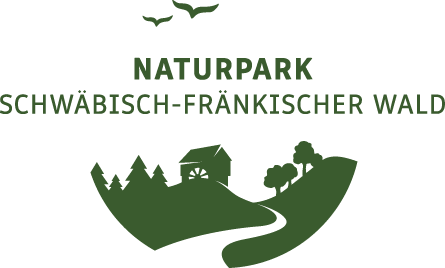Trekking Tips
Trekking
Tips
Home » Trekking Tips
What You Should Know
Gear Tips
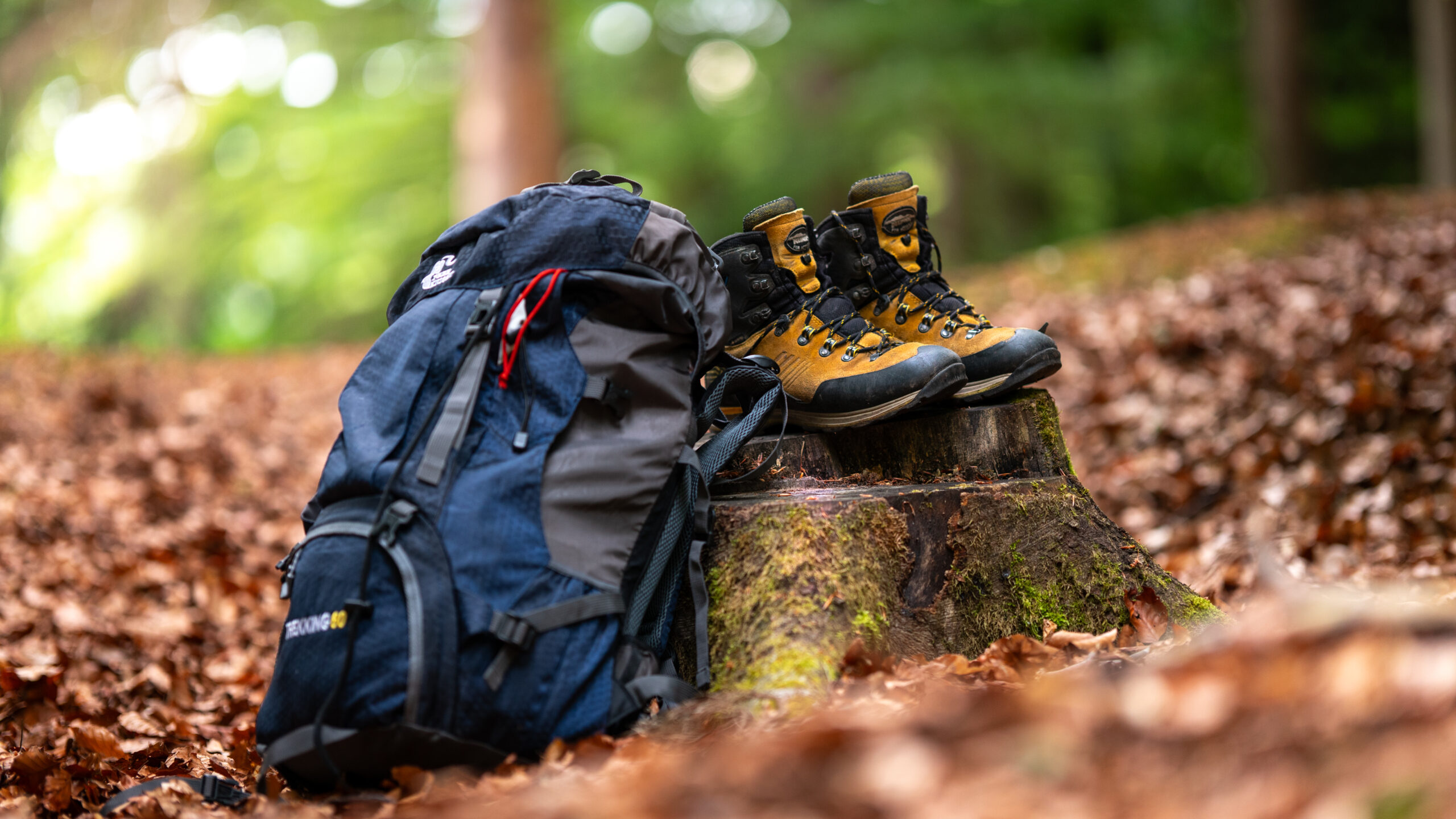
For a trekking tour through the Swabian-Franconian Forest, you don’t need high-end expedition gear – with thoughtful, functional equipment, you’ll be perfectly prepared. Here is a practical packing list.
Overnight Stay:
- Lightweight Trekking Tent (ideal weight up to 3 kg)
- Sleeping Bag (pay attention to your sleeping bag’s comfort temperature and the expected night temperatures for the region)
- Sleeping Pad for Comfortable Sleep
- Headlamp or Flashlight + Spare Battery or Batteries
Hygiene:
- Toothbrush
- Eco-Friendly Toothpaste or Tablets
- Biodegradable Outdoor Soap
- Small Quick-Dry Towel
- Toilet Paper
- Personal Hygiene Items
Food & Cooking:
- Water Bottle – Plan for 3–4 liters of water per person per day
- Optional: Water Filter or Purification Tablets
- Thermos Flask (for tea or coffee in the morning)
- Pocket Knife or Multi-Tool
- Cutlery & Lightweight Outdoor Cooking Pot
- Lightweight Camping Stove (observe forest fire regulations)
- Ingredients for Hot Meals – depending on the length of your tour
- Energy Bars, Nuts & Snacks for On-the-Go
Water Notice:
The trekking camps do not have a water supply. Nearby springs or streams often do not provide drinking water – especially in summer. Refill your water supplies along the way, for example at cemetery water points (note: not labeled as drinking water!). It’s better to carry a few liters too many than too few – for drinking, cooking, and washing.
Clothing:
- Sturdy Hiking Boots with Good Traction
- Functional Hiking Socks
- Layered Clothing: Functional T-Shirt, Long-Sleeve Shirt, Fleece or Sweater
- Comfortable Hiking Pants (short or long, depending on the weather)
- Rain Jacket & Rain Pants or Poncho
Health:
- Compact First Aid Kit (including blister plasters)
- Personal Medications
- Insect Repellent (preferably biodegradable)
- Hand Sanitizer
Miscellaneous:
- Trekking Backpack with Rain Cover
- Camp Booking Confirmation (digital copy is perfectly sufficient)
- ID / Identification Document
- Mobile Phone + Power Bank
- Lighter or Waterproof Matches
- Trash Bag – leave the site as clean as you found it
- Seat Cushion
- Trekking Poles (highly recommended depending on the weight of your backpack)
Weather & Safety
You can go on trekking hikes with overnight stays in any weather, following the motto: There’s no bad weather, only inappropriate clothing.
Of course, it’s more enjoyable to start your tour under a clear sky. Still, bad weather days can offer exciting moments as well. Fog in late summer or autumn makes the colorful forests appear especially mystical and mysterious, and short summer showers can easily be spent in one of the many forestry shelters or local inns. During cool, rainy weather, you often have the forest adventure entirely to yourself. Additionally, summers in recent years have been much more stable than before the turn of the millennium, with periods of good weather becoming longer.
Please check the current weather conditions before your tour – especially in cases of storms or strong winds. Pay attention to official warnings and closures, and adjust your route accordingly or turn back early if necessary.
During storms (from Beaufort scale 9) and lightning, there is a life-threatening risk from falling branches or toppling trees – even on hiking trails and at trekking camps.
If an official severe weather warning (level 3 or higher) is issued for the period of your booking and the surrounding area, and you reasonably decide not to stay overnight in the camp, please send us an email. We will take care of canceling the affected overnight stay afterward.
We do our best to update the hazard information on the trekking homepage in case of severe weather warnings (level 3 or higher according to the German Weather Service). Please understand that we cannot guarantee updates outside of business hours.
Please stay informed at all times. A good source for weather warnings, which displays severe weather alerts right on the homepage, is, for example, according to our recommendation: www.dwd.de
Safety:
Your safety comes first – plan ahead and stay alert!
The Swabian-Franconian Forest serves as a cool oasis away from the overheated metropolitan region. During the trekking season, however, the weather is usually pleasant for hiking. And if it gets too hot in the Stuttgart Basin, the Swabian-Franconian Forest offers a more comfortable regional climate, often with temperatures 5–8 degrees Celsius lower than many city centers in southwest Germany on hot days.
At temperatures above 35°C, you should at least pause your tour for a few hours in the afternoon and find a spot at the nearest outdoor swimming area. For example, the Bergsee in Gschwend is a great option.
Safe Stay in the Forest During Stormy Weather:
The responsible forest district managers regularly carry out the necessary safety maintenance at the trekking camps. They remove unsafe trees, branches, and deadwood. Regardless, YOU, as a trekking guest, are ultimately responsible for YOUR own safety along the trails and within the trekking camps.
Here are some tips for you:
- Always check the tree canopy above the spot where you plan to take a longer break. If you see dry, leafless branches, avoid that area, as there is a potential risk of falling branches.
- Always pay attention to the ground around the trees. If there is a lot of deadwood, it’s better to steer clear. If branches have already broken and fallen, this is likely to continue—even at low wind speeds.
Food & Supplies
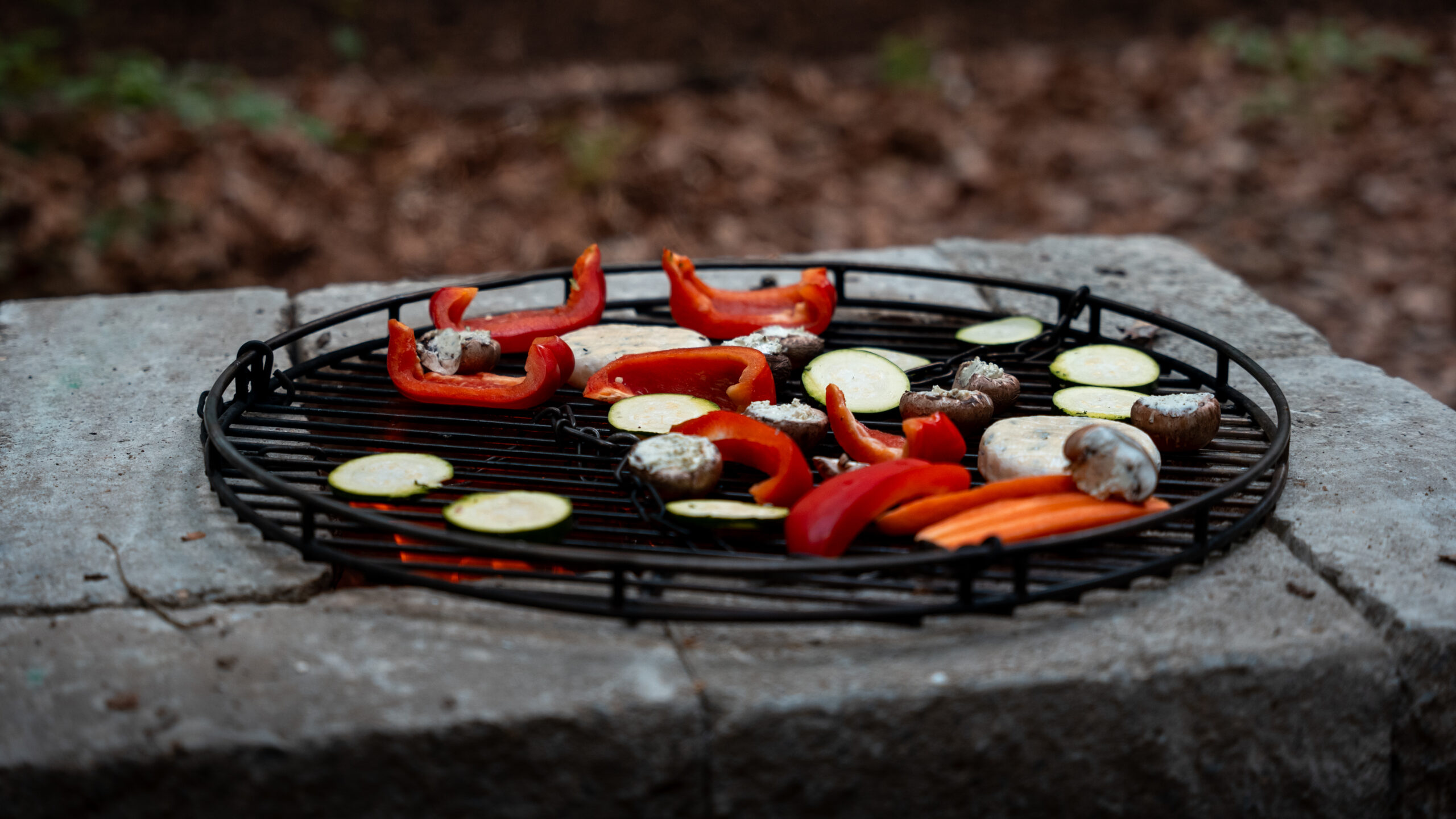
As a general rule: what you can cook at home can usually be prepared outdoors too – it just takes a bit more patience, practice, and care on a camping stove or fire pit. And that’s exactly the appeal: a genuine outdoor cooking experience.
Important: During high forest fire risk (level 4 or higher), even the stove must stay off! Then it’s all about creative outdoor cooking without an Open Flame. Don’t worry: we’ve got tips and recipes for that too!
Shop Locally – Directly Along Your Route:
In the Swabian-Franconian Forest Nature Park, you’ll find numerous spots along the trails to the camps for example direct marketers, farm shops, and regional vending machines, providing you with fresh regional products. From homemade sausages to cheese, eggs, bread, and seasonal vegetables, as well as honey or fruit spreads – here you can find everything you need for your trekking kitchen.
In the camp descriptions, you’ll find information about opportunities to purchase regional products along the route. From our experience: homemade meals taste even better outdoors. And if they come from the region, that’s like the cherry on top.
Transport & Storage on the Go:
To keep your food edible even after hours in your backpack, here are a few tips:
- Use insulated bags or lightweight containers for perishable foods
- Ideal for on the go: Whole cheese, smoked meat or bacon, hard sausages, pepper sticks, nuts, and firm vegetables
- Store everything deep in your backpack, preferably in a shaded spot
- Wrap a damp cloth around the container? Perfect – evaporation will help keep your food a bit cooler.
- At the camp: wrap food in a cloth, hang it in the air, or store it in a shaded spot.
Tip: With homemade dried vegetables or pre-made spice mixes, you can enhance any dish – completely free of additives. And if you don’t feel like chopping, there are ready-to-eat meals for trekking also a convenient addition.
Fire
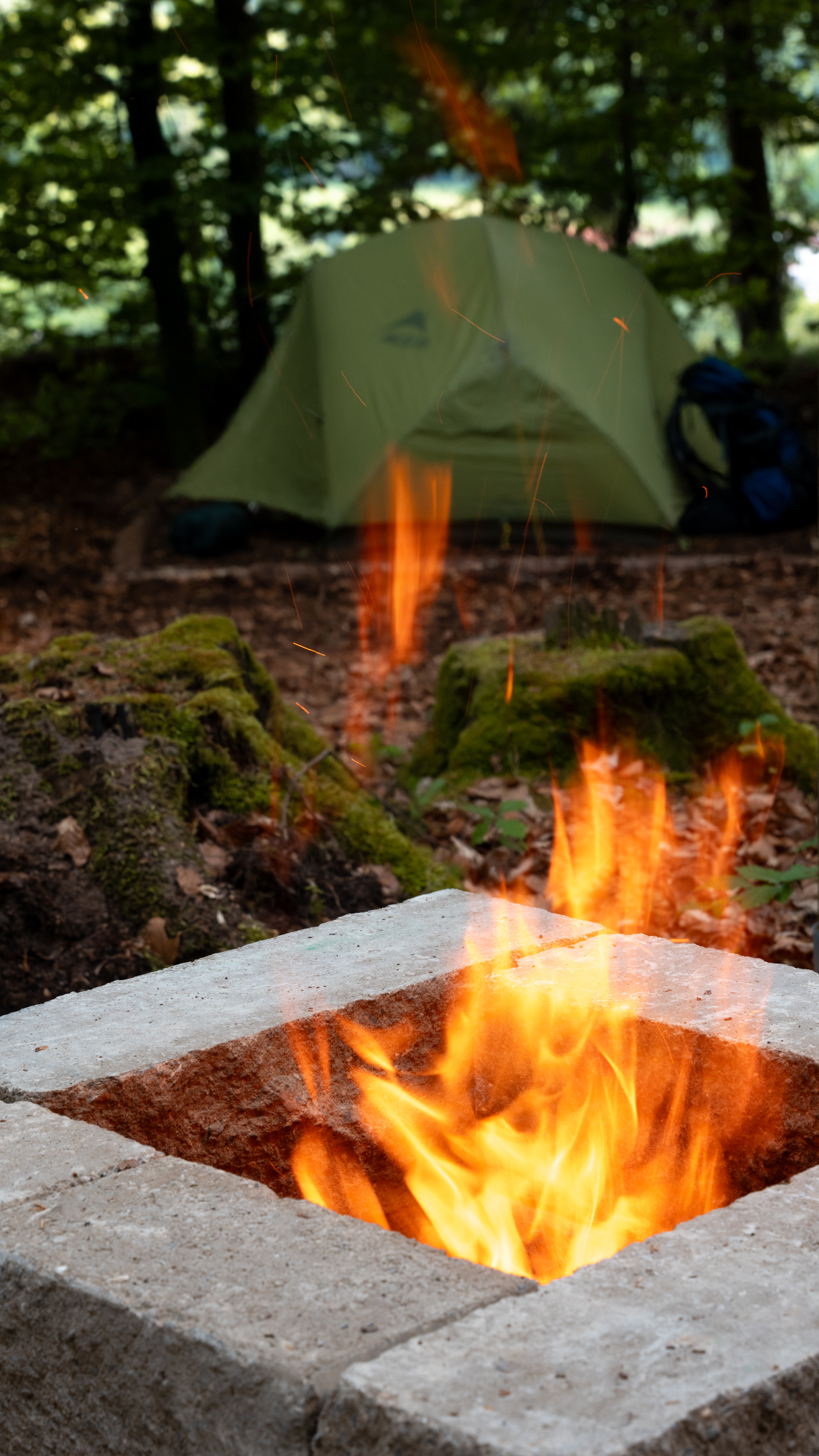
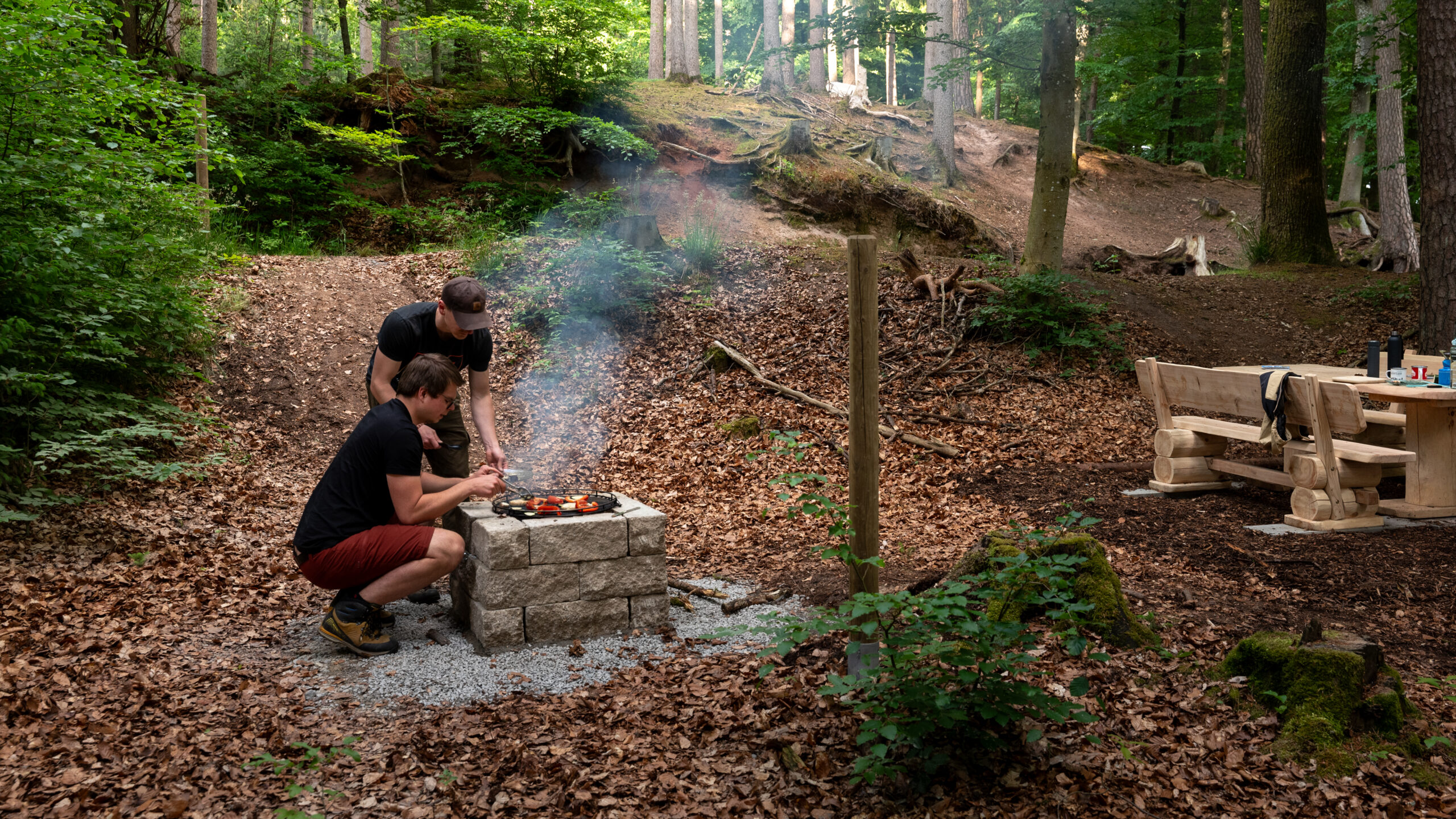
For the fire pit, we provide pre-cut, dry-stored logs (the lock code is included in your reservation email). Please use only as much as you need for cooking and leave enough wood for the next guests of the trekking camp – they will surely appreciate it.
The State Forest Act (LWaldG) in Baden-Württemberg legally regulates the use of fire, including at the trekking camps in the nature park.
- Please check the current forest fire danger level before and during your tour; it is available at the German Weather Service It can be found in the table under the station name Kaisersbach-Cronhütte (Rems-Murr District), which lists the forest fire danger level (WBI). Note: From warning level 4 onwards, no fires may be lit, and stoves with an open flame may no longer be used.
- We try to keep the forest fire danger level updated on the website and provide a warning at the time of booking if at least the fire pit cannot be used.
- Please use only the provided kindling or deadwood from the immediate camp area ➡️ avoid entering or collecting wood from the surrounding private forests.
General Fire Rules:
- Use only the official fire pit – do not create additional ones.
- Do not store flammable materials (e.g., branches, equipment) near the fire pit.
- Do not leave pots, stoves, or branches carelessly lying around the fireplace.
- Fire must always be supervised – even during brief absences.
- Before going to bed or leaving: Extinguish fire completely with water.
- Always have sufficient water available for extinguishing fires.
- Firewood: approximately forearm length, 3–4 cm thick, do not allow to protrude beyond the edge of the fire pit.
- Only burn wood provided or paper brought along for lighting purposes.
- Do not use flammable liquids for lighting ➡️ Risk of flash fires
- Cigarettes, lighters, and stoves are also considered open flames and are prohibited when there is an increased risk of forest fires.
- If you are traveling for a long period of time, it is best to check the current forest fire level regularly - especially in windy, hot, or dry conditions.
- Beware of flying sparks: plastic can melt and cause embers to ignite – particularly dangerous in windy conditions!
- Sufficient embers are required for cooking and grilling ➡️ only push the grill rack over the fire pit once the higher flames have subsided.
How do I light a fire in the barbecue area?
The so-called grid fire is a tried-and-tested method that almost always works. To do this, place two thicker pieces of wood side by side as a base and layer 3 to 4 layers of 3 to 4 pieces of wood laid crosswise on top. Place your ignition material in the middle under the wood pile – for example, brushwood, birch bark, paper, or a firelighter. After lighting, the fire burns from the bottom up through the wood structure. If the wood is damp, the fire will take a little patience. The flames dry the wood above before it starts to burn. Thin twigs placed between the thicker pieces of wood catch fire more quickly and support the flames.
How do I completely extinguish the fire?
Important: Sand is not a suitable extinguishing agent! Embers can remain hot for many hours or even days under a layer of sand and be reignited by the wind. Therefore, every fire must be extinguished with Water or another liquid to be completely extinguished to prevent uncontrolled reignition.
If only a small amount of water is available, the following trick can help:
Insert a small piece of twig into the neck of the bottle – this creates a kind of shower head through which the water flows slowly and precisely. In this way, with around one-third of the normal amount of waterthe fire gets permanently deleted.
When extinguishing the fire, you should carefully pull the embers apart with a stick and check all areas thoroughly. Continue extinguishing until no red or white glowing embers are visible anymore. Only when the undersides of the pieces of wood, which have been turned upwards, are completely black is the fire considered to be safely extinguished.
Nature conservation aspects
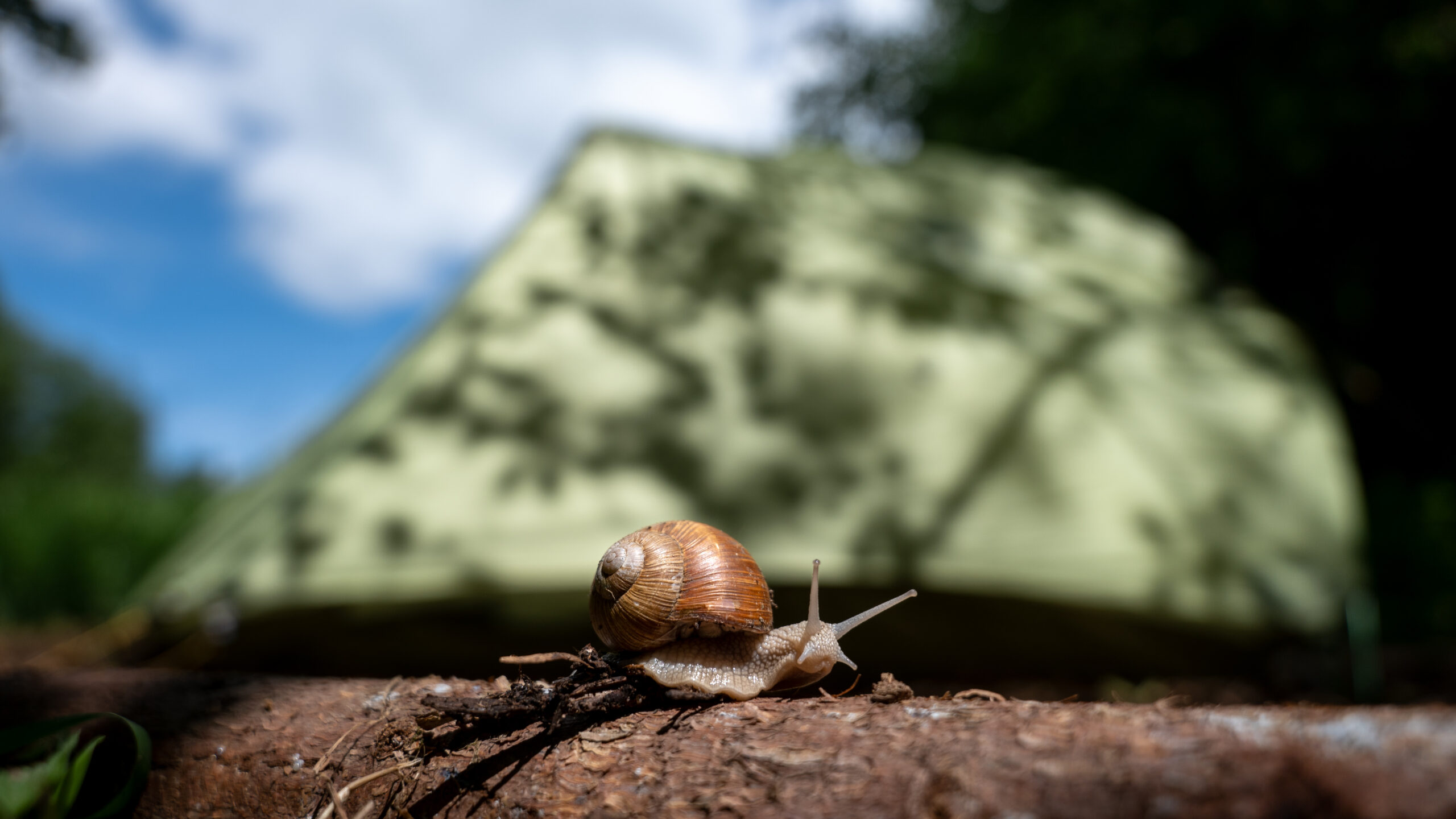
bewusstWild – Being considerate when traveling through wildlife habitats
You are sitting relaxed at the edge of your camp, enjoying the silence and watching the sun set between the trees. Suddenly, there is a rustling in the undergrowth – a deer cautiously emerges, pauses briefly... and flees in fright because a hiker is heading straight for you through the thicket. Voices, flashlights, frantic movements – the evening tranquility is gone.
Moments like these are more than just a disturbance for wild animals. What seems like a harmless encounter to us causes stress for many animals. If they have to flee, they lose valuable energy – especially at night, when they should be able to search for food undisturbed and feel safe.
Many wild animals have now withdrawn from daytime activity because humans are constantly using forests and paths. Nighttime is their refuge – which makes it all the more important that we leave them to it.
Two basic rules for harmonious coexistence with nature:
Stay on the path!
Animals have become accustomed to humans staying on designated paths. Off the beaten track, their habitats are disturbed. Therefore, stay on hiking and forest trails at all times – this protects animals, plants, and perhaps even your own sense of direction.
Leave the night to the animals!
Many wild animals are crepuscular and nocturnal. Noise, light, and movement disturb their nighttime foraging and disrupt their rhythm. Therefore, behave quietly in the evening and early morning hours – stay in camp during these times and do not go into the surrounding forests. This applies not only in designated nature reserves!
Important!
Spending the night outside of designated trekking camps is not permitted. There, you could find yourself in the middle of the habitat of deer, wild boar, foxes, or owls – and disturb the animals' nighttime rest. Join us in promoting a fair coexistence between humans and nature.
You can find out more about the bewusstWild initiative at: www.bewusstwild.de
Ausrüstungtipps:
For a trekking tour through the Swabian-Franconian Forest, you don’t need high-end expedition gear – with thoughtful, functional equipment, you’ll be perfectly prepared. Here is a practical packing list.
· Leichtes Trekkingzelt (Idealgewicht bis 3kg)
· Schlafsack (Beachte dabei die Komforttemperatur deines Schlafsacks und die angekündigten Nachttemperaturen für die Region)
· Isomatte für guten Schlafkomfort
· Stirnlampe oder Taschenlampe + Ersatzakku oder Batterien
· Zahnbürste
· Umweltfreundliche Zahnpasta oder Tabs
· Biologisch abbaubare Outdoor-Seife
· Kleines Handtuch (schnelltrocknend)
· Toilettenpapier
· Persönliche Hygieneartikel
· Trinkflasche ➡️ 3-4 Liter Wasser pro Person und Tag einplanen
· Optional: Wasserfilter oder Aufbereitungstabletten
· Thermosflasche (für Tee oder Kaffee am Morgen)
· Taschenmesser oder Multitool
· Besteck & leichter Outdoor-Kochtopf
· Leichter Campingkocher (Waldbrandgefahr)
· Zutaten für warme Mahlzeiten – je nach Dauer der Tour
· Energieriegel, Nüsse & Snacks für unterwegs
❗️Wasserhinweis:
The trekking camps do not have a water supply. Nearby springs or streams often do not provide drinking water – especially in summer. Refill your water supplies along the way, for example at cemetery water points (note: not labeled as drinking water!). It’s better to carry a few liters too many than too few – for drinking, cooking, and washing.
🧥 Kleidung
· Robuste Wanderschuhe mit gutem Profil
· Funktionale Wandersocken
· Zwiebellook: Funktionales T-Shirt, Langarmshirt, Fleece/Pullover
· Bequeme Wanderhose (kurz/lang je nach Wetter)
· Regenjacke & Regenhose oder Poncho
🩹 Gesundheit
· Kompaktes Erste-Hilfe-Set (inkl. Blasenpflaster!)
· Persönliche Medikamente
· Mückenschutz (biologisch abbaubar bevorzugt)
· Handdesinfektion
🎒 Sonstiges
· Trekkingrucksack mit Regenschutz
· Buchungsbestätigung fürs Camp (digital absolut ausreichend)
· Ausweis
· Handy + Powerbank
· Feuerzeug oder wasserfeste Streichhölzer
· Müllbeutel – du verlässt den Platz so sauber, wie du ihn vorgefunden hast
· Sitzkissen
· Trekkingstöcke (je nach Gewicht des Rucksackes sehr empfehlenswert)
Witterung:
You can go on trekking hikes with overnight stays in any weather, following the motto: There’s no bad weather, only inappropriate clothing.
Of course, it’s more enjoyable to start your tour under a clear sky. Still, bad weather days can offer exciting moments as well. Fog in late summer or autumn makes the colorful forests appear especially mystical and mysterious, and short summer showers can easily be spent in one of the many forestry shelters or local inns. During cool, rainy weather, you often have the forest adventure entirely to yourself. Additionally, summers in recent years have been much more stable than before the turn of the millennium, with periods of good weather becoming longer.
Please check the current weather conditions before your tour – especially in cases of storms or strong winds. Pay attention to official warnings and closures, and adjust your route accordingly or turn back early if necessary.
During storms (from Beaufort scale 9) and lightning, there is a life-threatening risk from falling branches or toppling trees – even on hiking trails and at trekking camps.
If an official severe weather warning (level 3 or higher) is issued for the period of your booking and the surrounding area, and you reasonably decide not to stay overnight in the camp, please send us an email. We will take care of canceling the affected overnight stay afterward.
We do our best to update the hazard information on the trekking homepage in case of severe weather warnings (level 3 or higher according to the German Weather Service). Please understand that we cannot guarantee updates outside of business hours.
Please stay informed at all times. A good source for weather warnings, which displays severe weather alerts right on the homepage, is, for example, according to our recommendation: www.dwd.de
Your safety comes first – plan ahead and stay alert!
Schwäbisch-Fränkischer Wald als Kühle Oase abseits der überhitzten Metropolregion.
Meist ist in der Trekking-Saison jedoch angenehmes Wetter für eine Wanderung vorherrschend. Und sollte es im Stuttgarter Kessel mal wieder zu heiß sein, bietet der Schwäbisch-Fränkische Wald ein angenehmeres Regionalklima und weist bei Hitzetagen häufig 5-8 Grad tiefere Temperaturen als so manches südwestdeutsches Stadtzentrum auf.
At temperatures above 35°C, you should at least pause your tour for a few hours in the afternoon and find a spot at the nearest outdoor swimming area. For example, the Bergsee in Gschwend is a great option.
Safe Stay in the Forest During Stormy Weather:
The responsible forest district managers regularly carry out the necessary safety maintenance at the trekking camps. They remove unsafe trees, branches, and deadwood. Regardless, YOU, as a trekking guest, are ultimately responsible for YOUR own safety along the trails and within the trekking camps.
Here are some tips for you:
· Schaue stets in die Baumkrone, unter der du eine längere Pause einlegen möchtest. Sind hier dürre, blattlose Äste zu erkennen, meide diesen Bereich. Hier besteht potenziell Gefahr durch herabfallende Äste
· Achte immer auf den Boden um die Bäume herum. Wenn dort sehr viel Totholz liegt, mache besser einen großen Bogen. Wenn Äste schon abgebrochen und herabgefallen sind, wird dies auch weiter passieren. Dazu reichen auch geringe Windgeschwindigkeiten aus.
Verpflegung:
As a general rule: what you can cook at home can usually be prepared outdoors too – it just takes a bit more patience, practice, and care on a camping stove or fire pit. And that’s exactly the appeal: a genuine outdoor cooking experience.
Important: During high forest fire risk (level 4 or higher), even the stove must stay off! Then it’s all about creative outdoor cooking without an Open Flame. Don’t worry: we’ve got tips and recipes for that too!
🥕 Regional einkaufen – direkt auf deiner Route
In the Swabian-Franconian Forest Nature Park, you’ll find numerous spots along the trails to the camps for example direct marketers, farm shops, and regional vending machines, providing you with fresh regional products. From homemade sausages to cheese, eggs, bread, and seasonal vegetables, as well as honey or fruit spreads – here you can find everything you need for your trekking kitchen.
In the camp descriptions, you’ll find information about opportunities to purchase regional products along the route. From our experience: homemade meals taste even better outdoors. And if they come from the region, that’s like the cherry on top.
🧺 Transport & Lagerung unterwegs
To keep your food edible even after hours in your backpack, here are a few tips:
· Verwende insulated bags or lightweight containers for perishable foods
· Ideal für unterwegs: Whole cheese, smoked meat or bacon, hard sausages, pepper sticks, nuts, and firm vegetables
· Lagere alles deep in your backpack, preferably in a shaded spot
· Feuchtes Tuch um die Box gewickelt? Perfekt – durch Verdunstung bleiben deine etwas kühler
· Im Camp: Lebensmittel in ein Tuch schlagen, luftig aufhängen oder an einem schattigen Platz lagern
Tip: With homemade dried vegetables or pre-made spice mixes, you can enhance any dish – completely free of additives. And if you don’t feel like chopping, there are ready-to-eat meals for trekking also a convenient addition.
Fire:
For the fire pit, we provide pre-cut, dry-stored logs (the lock code is included in your reservation email). Please use only as much as you need for cooking and leave enough wood for the next guests of the trekking camp – they will surely appreciate it.
The State Forest Act (LWaldG) in Baden-Württemberg legally regulates the use of fire, including at the trekking camps in the nature park.
· Bitte informiere dich vor und während deiner Tour über die aktuelle Waldbrandgefahrenstufe, diese ist beim German Weather Service It can be found in the table under the station name Kaisersbach-Cronhütte (Rems-Murr District), which lists the forest fire danger level (WBI). Note: From warning level 4 onwards, no fires may be lit, and stoves with an open flame may no longer be used.
· Wir versuchen auf der Website die Waldbrandgefahrenstufe aktuell zu halten und euch schon bei der Buchung den Hinweis zu geben, dass zumindest die Feuerstelle nicht nutzbar ist
· Bitte nutze für das Finden von Anzündholz lediglich das bereitgestellte Anzündholz oder Totholz aus der unmittelbaren Campumgebung
➡️ vermeide das Betreten bzw. das Sammeln von Holz in den angrenzenden Privatwäldern
General Fire Rules:
Use only the official fire pit – do not create additional ones.
· Keine brennbaren Materialien (z. B. Äste, Ausrüstung) in der Nähe der Feuerstelle lagern
· Töpfe, Kocher oder Äste nicht achtlos rund um die Feuerstelle liegen lassen
· Feuer muss immer beaufsichtigt werden – auch bei kurzer Abwesenheit.
· Vor dem Schlafengehen oder Verlassen: Feuer vollständig mit Wasser löschen
· Immer ausreichend Löschwasser bereithalten.
· Brennholz: etwa unterarmlang, 3–4 cm dick, nicht über den Rand der Feuerstelle hinausragen lassen.
· Nur bereitgestelltes Holz oder mitgebrachtes Papier zum Anzünden verbrennen
· Keine brennbaren Flüssigkeiten zum Anzünden verwenden ➡️ Gefahr von Stichflammen
· Zigaretten, Feuerzeuge und Kocher gelten ebenfalls als offenes Feuer – bei erhöhter Waldbrandgefahr verboten.
· Wenn du längere Zeit unterwegs bist, am besten regelmäßig die aktuelle Waldbrandstufe prüfen – besonders bei Wind, Hitze oder Trockenheit
· Funkenflug beachten: kann Kunststoff schmelzen und Glutnester verursachen – besonders gefährlich bei Wind!
· Zum Kochen und Grillen wird ausreichend Glut benötigt
➡️ erst nach Abflauen der höheren Flammen Grillrost über den Feuerschlund schieben
How do I light a fire in the barbecue area?
The so-called grid fire ist eine bewährte Methode, die fast immer funktioniert. Dazu legst du zwei dickere Hölzer als Basis nebeneinander und schichtest darauf 3 bis 4 Lagen aus jeweils 3 bis 4 quergelegten Holzstücken.
In der Mitte unter dem Holzstapel platzierst du dein Zündmaterial – zum Beispiel Reisig, Birkenrinde, Papier oder einen Anzünder. Nach dem Anzünden brennt das Feuer von unten nach oben durch den Holzaufbau.
Wenn das Holz feucht ist, braucht das Feuer etwas Geduld. Die Flammen trocknen das darüberliegende Holz, bevor es zu brennen beginnt. Dünne Zweige, die du zwischen die dickeren Hölzer legst, fangen schneller Feuer und unterstützen die Flammen.
How do I completely extinguish the fire?
Important: Sand is not a suitable extinguishing agent!
Embers can remain hot for many hours or even days under a layer of sand and be reignited by the wind. Therefore, every fire must be extinguished with Water or another liquid to be completely extinguished to prevent uncontrolled reignition.
If only a small amount of water is available, the following trick can help:
Insert a small piece of twig into the neck of the bottle – this creates a kind of shower head through which the water flows slowly and precisely. In this way, with around one-third of the normal amount of waterthe fire gets permanently deleted.
Beim Löschen solltest du mit einem Stock die Glut vorsichtig auseinanderziehen und alle Stellen gründlich kontrollieren.
Lösche so lange, bis no red or white glowing embers are visible anymore. Only when the undersides of the pieces of wood, which have been turned upwards, are completely black is the fire considered to be safely extinguished.
Naturschutzaspekte:
bewusstWild – Being considerate when traveling through wildlife habitats
You are sitting relaxed at the edge of your camp, enjoying the silence and watching the sun set between the trees. Suddenly, there is a rustling in the undergrowth – a deer cautiously emerges, pauses briefly... and flees in fright because a hiker is heading straight for you through the thicket. Voices, flashlights, frantic movements – the evening tranquility is gone.
Moments like these are more than just a disturbance for wild animals. What seems like a harmless encounter to us causes stress for many animals. If they have to flee, they lose valuable energy – especially at night, when they should be able to search for food undisturbed and feel safe.
Many wild animals have now withdrawn from daytime activity because humans are constantly using forests and paths. Nighttime is their refuge – which makes it all the more important that we leave them to it.
Zwei Grundregeln für ein gutes Miteinander mit der Natur
Bleib auf dem Weg.
Animals have become accustomed to humans staying on designated paths. Off the beaten track, their habitats are disturbed. Therefore, stay on hiking and forest trails at all times – this protects animals, plants, and perhaps even your own sense of direction.
Gib die Nacht den Tieren.
Many wild animals are crepuscular and nocturnal. Noise, light, and movement disturb their nighttime foraging and disrupt their rhythm. Therefore, behave quietly in the evening and early morning hours – stay in camp during these times and do not go into the surrounding forests. This applies not only in designated nature reserves!
Important: Das Übernachten außerhalb der ausgewiesenen Trekking-Camps ist nicht erlaubt. Dort könntest du mitten im Lebensraum von Reh, Wildschwein, Fuchs oder Eule liegen – und die Tiere in ihrer Nachtruhe empfindlich stören.
Mach mit – für ein faires Miteinander von Mensch und Natur.
You can find out more about the bewusstWild initiative at:
👉 www.bewusstwild.de
